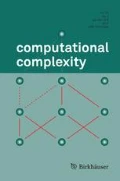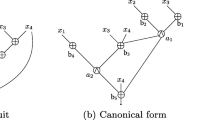Abstract
Define the MOD m -degree of a boolean functionF to be the smallest degree of any polynomialP, over the ring of integers modulom, such that for all 0–1 assignments\(\vec x\),\(F(\vec x) = 0\) iff\(P(\vec x) = 0\). We obtain the unexpected result that the MOD m -degree of the OR ofN variables is\(O(\sqrt[\tau ]{N})\), wherer is the number of distinct prime factors ofm. This is optimal in the case of representation by symmetric polynomials. The MOD n function is 0 if the number of input ones is a multiple ofn and is one otherwise. We show that the MOD m -degree of both the MOD n and\(\neg MOD_n\) functions isN Ω(1) exactly when there is a prime dividingn but notm. The MOD m -degree of the MOD m function is 1; we show that the MOD m -degree of\(\neg MOD_m\) isN Ω(1) ifm is not a power of a prime,O(1) otherwise. A corollary is that there exists an oracle relative to which the MOD m P classes (such as ⊕P) have this structure: MOD m P is closed under complementation and union iffm is a prime power, and MOD n P is a subset of MOD m P iff all primes dividingn also dividem.
Similar content being viewed by others
References
L. Babai and L. Fortnow, A characterization of #P by arithmetic straight-line programs. InProc. 31st Ann. IEEE Symp. Found. of Comput. Sci., 1990, 26–34.
L. Babai, N. Nisan, and M. Szegedy, Multiparty protocols and pseudorandom sequences. InProc. Twenty-first ACM Symp. Theor. Comput., 1989, 1–11.
D. A. Barrington,Width 3 permutation branching programs. Technical Report TM-291, MIT Laboratory for Computer Science, Cambridge, Mass., Dec. 1985.
D. A. Barrington,A note on a theorem of Razborov. Technical Report COINS TR 87-93, COINS Dept., U. of Massachusetts, Amherst, Mass., July 1986.
D. A. Barrington, Bounded-width polynomial-size branching programs recognize exactly those languages inNC 1.J. Comput. System Sci. 38 (1989), 150–164.
D. A. M. Barrington,The current state of circuit lower bounds. Technical Report COINS TR 90-61, COINS Dept., U. of Massachusetts, Amherst, Mass., July 1990.
D. A. M. Barrington, Some problems involving Razborov-Smolensky polynomials. InBoolean Function Complexity, ed.M. S. Patterson, London Mathematical Society Lecture Note Series 169, Cambridge University Press, 1992a, 109–128.
D. A. M. Barrington, Quasipolynomial size circuit complexity. InStructure in Complexity Theory: Seventh Annual Conference, 1992b, 86–93.
D. A. M. Barrington, R. Beigel, and S. Rudich, Representing Boolean functions as polynomials modulo composite numbers. InProc. Twenty-fourth ACM Symp. Theor. Comput., 1992, 455–461.
D. A. M. Barrington, H. Straubing, andD. Thérien, Non-uniform automata over groups.Inform. and Comput. 89 (1990), 109–132.
D. A. M. Barrington andD. Thérien, Finite monoids and the fine structure ofNC 1.J. Assoc. Comp. Mach. 35 (1988), 941–952.
R. Beigel, Relativized counting classes: Relations among thresholds, parity, and mods.J. Comput. System Sci. 42 (1991), 76–96.
R. Beigel andJ. Gill, Counting classes: Thresholds, parity, mods, and fewness.Theoret. Comput. Sci. 103 (1992), 3–23.
R. Beigel and J. Tarui, On ACC. InProc. 32nd Ann. IEEE Symp. Found. Comput. Sci., 1991, 783–792. Revised version in this volume.
J. Cai andL. Hemachandra, On the power of parity polynomial time.Math. Systems Theory 23 (1990), 95–106.
M. Furst, J. B. Saxe, andM. Sipser, Parity, circuits, and the polynomial-time hierarchy.Math. Systems Theory 17 (1984) 13–27.
L. Goldschlager andI. Parberry, On the construction of parallel computers from various bases of Boolean functions.Theoret. Comput. Sci. 43 (1986), 43–58.
V. Grolmusz,On the Weak Mod-m Degree of the GIP Function. Draft, Eötvös University, April 1994.
U. Hertrampf, Relations among MOD-classes.Theoret. Comput. Sci. 74 (1990), 325–328.
M. Krause and S. Waack, Variation ranks of communication matrices and lower bounds for depth two circuits having symmetric gates with unbounded fan-in. InProc. 32nd Ann. IEEE Symp. Found. Comput. Sci., 1991, 777–782.
P. McKenzie, P. Péladeau andD. Thérien,NC 1: the automata-theoretic viewpoint.Comput. Complexity 1 (1991), 330–359.
M. L. Minsky andS. A. Papert,Perceptrons. MIT Press, Cambridge, MA, 1988. Expanded Edition. The first edition appeared in 1968.
C. Papadimitriou andS. Zachos, Two remarks on the power of counting.Proc. Sixth GI Conf. Theoret. Comp. Sci., Lecture Notes in Computer Science 145, Springer-Verlag, Berlin, 1983, 269–276.
A. A. Razborov, Lower bounds for the size of circuits of bounded depth with basis {Λ,⊕}.Math. Notes of the Academy of Science of the USSR 41 (1987), 333–338.
R. Smolensky, Algebraic methods in the theory of lower bounds for Boolean circuit complexity. InProc. Nineteenth Ann. ACM Symp. Theor. Comput., 1987, 77–82.
R. Smolensky, On interpretation by analytic functions with special properties and some weak lower bounds on the size of circuits with symmetric gates. InProc. 31st Ann. IEEE Symp. Found. Comput. Sci., 1990, 628–631.
M. Szegedy,Algebraic Methods in Lower Bounds for Computational Models with Limited Communication. Ph.D. thesis, University of Chicago, Dec. 1989.
G. Tardos and D. A. M. Barrington,A Lower Bound on the Mod 6 Degree of the OR Function. Draft, U. of Massachusetts, April 1994.
J. Tarui, Probabilistic polynomials, AC0 functions, and the polynomial-time hierarchy.Theoret. Comput. Sci. 113 (1993), 167–183.
D. Thérien, Circuits of MODm gates cannot compute AND in sublinear size. InProc. LATIN '92 (First Latin American Symposium on Theoretical Computer Science), 1992. Revised version in this volume.
S. Toda andM. Ogiwara, Counting classes are at least as hard as the polynomial-time hierarchy.SIAM J. Comput. 21 (1992), 316–328.
S.-C. Tsai, Lower bounds on representing Boolean functions as polynomials inZ m . InProc. Structure in Complexity Theory: Eighth Ann. Conference, 1993, 96–101.
A. C.-C. Yao, On ACC and threshold circuits. InProc. 31st Ann. IEEE Symp. Found. Comput. Sci., 1990, 619–627.
Author information
Authors and Affiliations
Rights and permissions
About this article
Cite this article
Barrington, D.A.M., Beigel, R. & Rudich, S. Representing Boolean functions as polynomials modulo composite numbers. Comput Complexity 4, 367–382 (1994). https://doi.org/10.1007/BF01263424
Received:
Issue Date:
DOI: https://doi.org/10.1007/BF01263424




